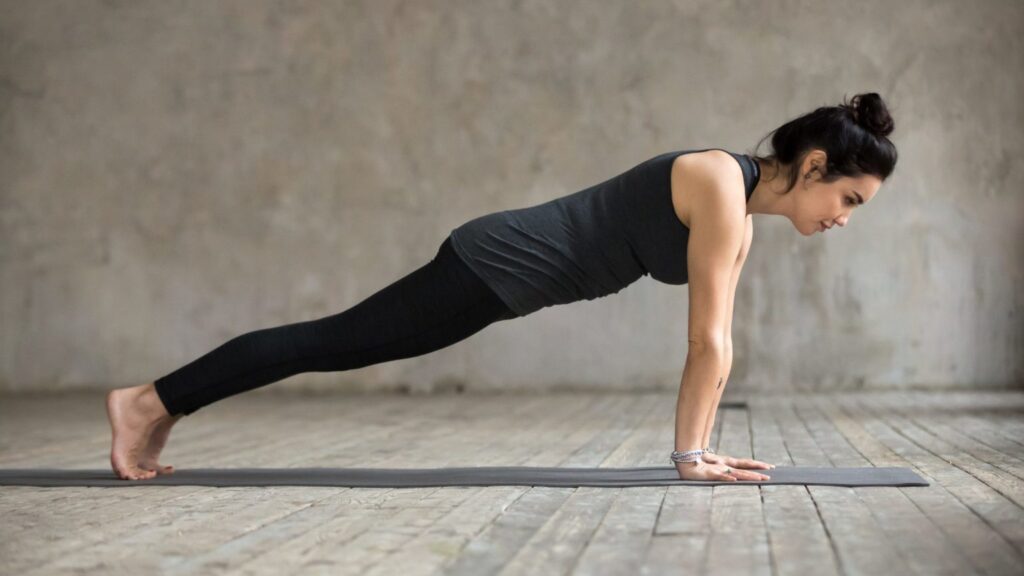
Among all yoga poses, Plank Pose (Phalakasana) stands out as a powerful foundation. Simple in appearance, yet intense in execution, Plank Pose strengthens not only the body but also the mind. It teaches us to stay steady, to hold firm, and to breathe through challenges—both on and off the mat.
Whether you’re a beginner building core strength or an advanced yogi refining your alignment, Plank Pose is a fundamental posture you’ll revisit time and time again.
What is Plank Pose?
Plank Pose is a full-body strength posture in yoga that mimics the top of a push-up. The body forms a straight line from head to heels, supported by the hands and toes. While it may look simple, maintaining the correct form requires serious engagement of your core, shoulders, arms, and legs.
How to Practice Plank Pose
Here’s a step-by-step guide to practicing Plank Pose safely:
-
Start in Tabletop Position (on your hands and knees).
-
Step your feet back one at a time until your legs are straight behind you.
-
Your shoulders should be stacked directly over your wrists.
-
Keep your body in a straight line from head to heels—avoid sagging or lifting the hips.
-
Engage your core, squeeze your glutes, and press your heels back.
-
Hold for 30 seconds to 1 minute, breathing deeply.
Benefits of Plank Pose
Plank Pose offers a wide range of benefits that go beyond just the physical:
-
Strengthens the Core: Builds deep abdominal strength and stability.
-
Tones Arms and Shoulders: A great way to develop upper-body endurance.
-
Improves Posture: Reinforces spinal alignment and back strength.
-
Boosts Mental Focus: Holding the pose builds resilience and mindfulness.
-
Enhances Balance: A strong plank improves balance in more advanced poses.
Plank yoga Pose Variations
If you’re ready to mix things up, try these fun variations:
-
Forearm Plank: Lower down to your forearms for more focus on core engagement.
-
Side Plank (Vasisthasana): Shift your weight to one side and stack your feet for a side-body challenge.
-
Plank to Chaturanga: Lower into a yoga push-up to flow into a vinyasa sequence.
-
Knee Plank: A gentler option for beginners or anyone with wrist or core limitations.
Common Mistakes to Avoid
-
Sagging Hips: This strains your lower back. Keep your core tight.
-
Butt Too High: Avoid creating a V-shape; maintain a straight line.
-
Locked Elbows: Slightly bend your elbows to avoid joint strain.
-
Neck Strain: Keep your gaze down and your neck in line with your spine.
Conclusion
Plank Yoga Pose is more than a strength-builder—it’s a mirror. It reflects your determination, your alignment, and your focus. From beginner sequences to advanced flows, it shows up as a silent powerhouse that holds everything together. Incorporating Plank Yoga Pose regularly into your practice can elevate your strength, stamina, and inner stillness.
So the next time you’re in Plank, remember: it’s not just about holding your body up—it’s about rising to the challenge, one breath at a time.
FAQs About Plank Yoga Pose Yoga
1. Is Plank yoga Pose good for beginners?
Yes! Beginners can start with a Knee Plank variation and gradually build strength to hold the full pose.
2. How long should I hold Plank Pose?
Start with 20–30 seconds and increase over time. Aim for up to 1–2 minutes with good form.
3. Does Plank yoga Pose help with weight loss?
While not a cardio exercise, Plank yoga Pose builds lean muscle and boosts core strength, which can contribute to overall fat burning when combined with a balanced routine.
4. Can Plank Yoga Pose hurt my back?
If done incorrectly—yes. Always engage your core and avoid letting your hips sag. If you feel back pain, modify or consult a yoga teacher.
5. How often should I include Plank Pose in my practice?
Daily is great, even for a short hold. It’s a versatile posture that complements nearly every type of yoga sequence.





